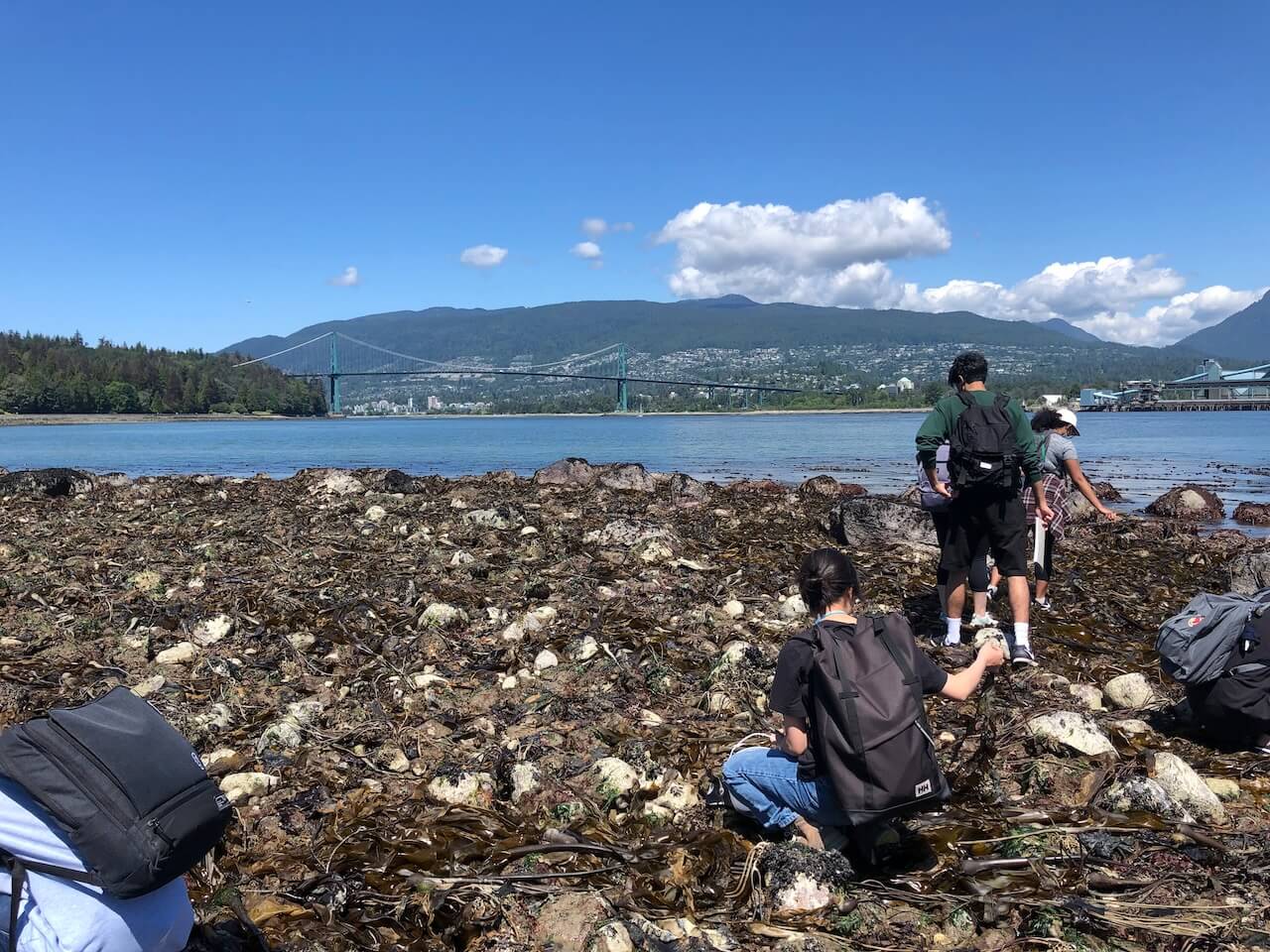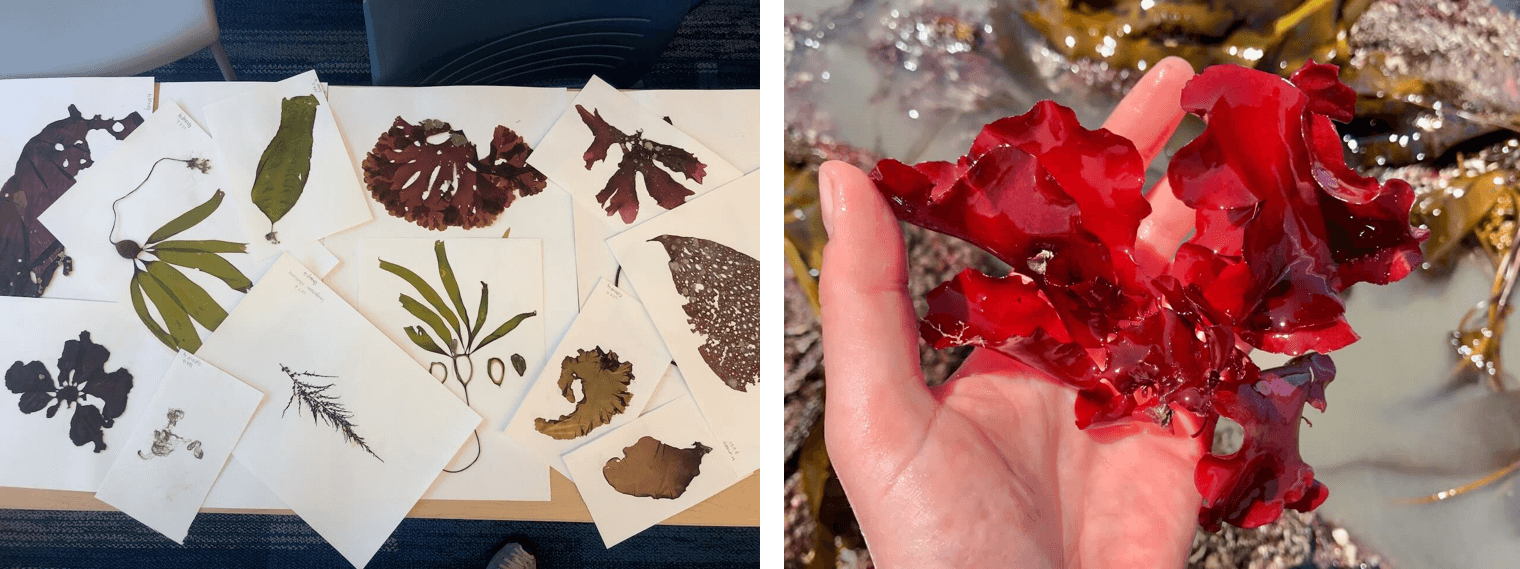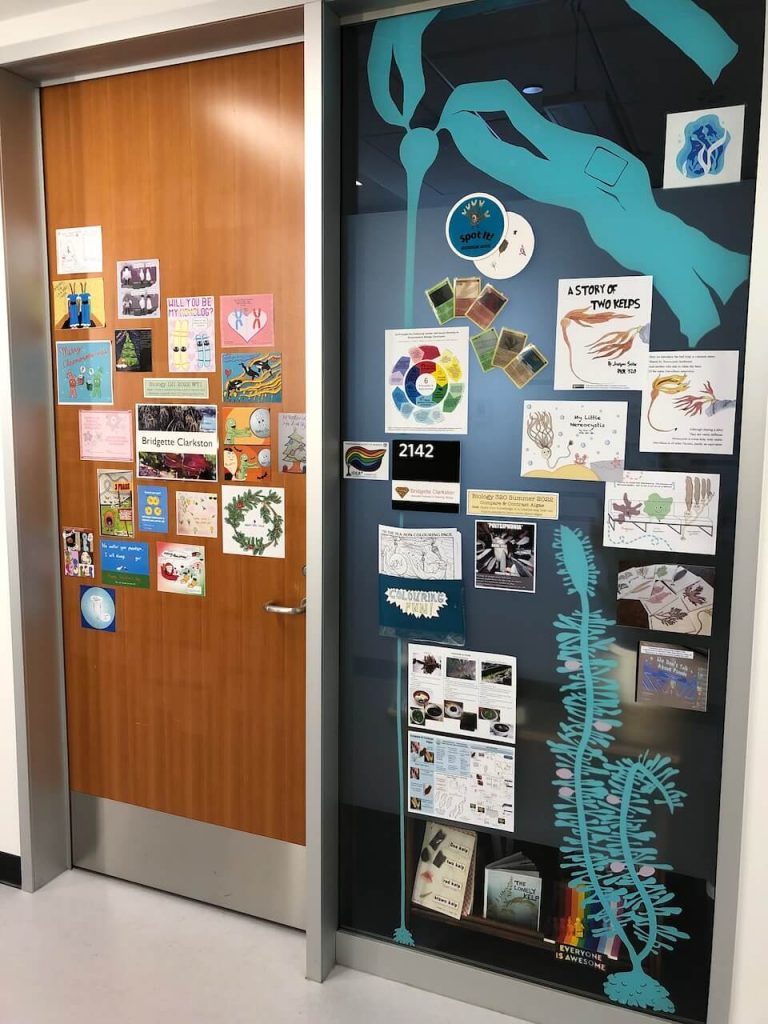
Bridgette Clarkston recently taught the first ever summer offering of Biol 320 (Survey of the Algae), which is a 3rd-year organismal lab course focused on exploring the biodiversity, ecology, evolution and human connections to macro- and micro-algae.
Local seaweeds are a major course focus and Bridgette decided to pilot two new class projects around them that focused on community partnerships and experiential learning: a Compare & Contrast Algae-in-Art project, and a Seaweed Species Richness of Stanley Park project. “I was so excited because seaweeds are at their peak in late spring-early summer.”
Below, Bridgette describes why and how she included these two new projects in the course, the impact they had on students, and what she learned along the way.
Tell us about these course projects and what you were trying to achieve.
For the Compare & Contrast project, my goal was for students to apply their Biol 320 knowledge of algae in a creative way that can inspire people outside of the course to learn more about algae. Students worked alone or with a partner and were tasked with creating an interactive product — could be visual, written, or other — that compared and contrasted different types of algae and had educational value outside of the course. To “compare and contrast” two or more things means observing and noticing what makes those things similar to and different from each other. Comparing can involve similarities or differences, contrasting is specific to differences. Building skills of observation and comparing/contrasting is a key goal of Biol 320 (and, frankly, any other organismal biology course).
For the Stanley Park project, my goal was for students to apply their lab-developed knowledge of local seaweeds in the field. Students worked in groups of 3-4 to collect, identify, document and preserve a selection of red, brown and green seaweeds. We pooled everyone’s efforts to generate a species richness list for the Stanley Park Ecology Society, a class set of observations for the iNaturalist citizen science database, and a collection of pressed seaweed specimens for the Beaty Biodiversity Museum.
What was the result?
For the Compare and Contrast project, I honestly don’t think I can overstate the benefits of including a creative component into a biology course. In other courses I’ve included creative assignments like biology-themed holiday cards (Biol 121), or algae posters for young kids (Biol 209) and every time the effort that most students put in blows me away. Biol 320 was no exception. We had several hand-illustrated children’s books, an original lyrics to the “We don’t talk about Bruno” presented karaoke-style to the class, algae Pokémon cards, kelp brownies, several hand-drawn seaweed “memory” card games, algae memes and more. I’ve compiled examples (shared with students’ permission) and the project instructions in this Google Drive folder and some examples are shown below. I hope others will be inspired to try out a project like this and I’d love to hear how colleagues are incorporating creative activities in their own biology courses.

For the Stanley Park project, I was extremely delighted by the high-quality products that we produced that have value outside the course. Collectively, students prepared 110 herbarium specimens that we donated as a class to the Beaty Biodiversity Museum. Linda Lipsen, Beaty Collections Curator of Vascular Plants & Algae, originally suggested the idea of submitting our collections because in recent years the Beaty Museum has received no local Vancouver seaweed specimens. As a class, we prepared a species richness list for the Stanley Park Ecology Society that included 43 species, five of which the Society did not have recorded on their life list. One GORGEOUS find was the red seaweed Opuntiella californica (see photo below). The Ecology Society’s Conservation Projects Manager Dacyn Holinda joined us on a field trip and talked about the Society’s desire for more class partnerships like ours. Finally, we created 168 seaweed specimen records on our iNaturalist project webpage, most of which have at least two photographs and are of research-grade quality and all I reviewed for quality and accuracy of identification. I’ve compiled examples of anonymized student reflections (shared with students’ permission) and the project instructions in this Google Drive folder.

Also, I was inspired by Celeste Leander’s recent blog post to try ungrading as the assessment strategy for both of these projects. I’m really happy with this decision, as the honest feedback and reflection that the students provided, as well as the humble and thoughtful view they took of their own efforts, were inspiring and heartwarming to read.
How did students responded to the projects?
I will let students speak for themselves about their responses to these two projects. The two Google Drive folders linked above contain full reflections for both projects submitted by a selection of students, and here are some statements that stuck out to me:
“Despite working on the [Compare & Contrast] project for the better half of four days, the work didn’t really feel like work because I was enjoying myself the whole time. I think I may have even discovered a new hobby, because I had lots of fun doing the digital drawing!” – Student who created original algae Pokémon cards.
“I felt overwhelmed with the fact that we could choose any aspect of the course and the amazing algae to choose from. However, I decided to choose an aspect of the course that initially confused me in order to solidify my learning for the final… I am extremely proud of my project because I went out of my comfort zone to create it and then present it to the class. I learned that going out of your comfort zone is fun!” – Student who presented a karaoke sing-along of “We don’t talk about Bruno” with new lyrics that contrasted cellular construction of red algae.
“Preserving specimens was a really unique experience as it almost felt like art to me. Being able to see the final preserved herbarium specimens was really “cool” and it was the first time I have ever preserved any live specimen and not just work on previously preserved specimens.” – Student talking about creating their pressed herbarium samples from their collected seaweed specimens.
“Through this experience of contributing to a citizen science project, I was able to realize I have a big interest in algae. For example, I spent quite some time trying to get the presses to look the best so they can be seen by others.” – A second student talking about their iNaturalist records and pressed herbarium samples.
What did you learn or find surprising?
I learn many things every time I teach, and in this case, I learned how satisfying it is to see students’ pride in knowing their work is contributing to something outside the course. I was also absolutely surprised and delighted by the effectiveness of the ungrading approach, something that actually took less effort than I expected with an absolutely huge return on my investment.
One small delightful surprise was the apparent benefit of doing two intertidal field trips to the same location. I agonized about whether I should take students to two different sites so they could experience intertidal variety, or perhaps one marine and one freshwater trip? Hours I spent on this internal debate. In the end, logistical simplicity won out — especially with respect to organizing public transit directions — and we visited Empress Figurehead at Stanley Park twice. Turns out that seeing two different low tide heights (0.0m vs 0.5m) had a big impact as many students said things like: “I remember on the first trip the tidal zone was so low we could see the exposed Nereocystis but when we came back on the second field trip I was initially confused at where all the Nereocystis have gone.” and “On the first trip, I remember Dr. Clarkston stating that the low tide on that particular date is not an often occurrence. I didn’t understand how special that was until I went on the second Stanley Park trip, and realized that almost all the Nereocystis were underwater!”
What advice would you give someone who wanted to do something similar in their own course?
Check out Celeste’s blog post on ungrading! And don’t be afraid to include an ungrading assignment but still have traditionally-graded tests, etc. In my personal experience, the students don’t have an issue distinguishing the two methods. Also, folks over at the Beaty Biodiversity Museum are eager to collaborate more with courses, so if you’re interested, please do reach out to them (or I’m happy to facilitate any introductions).
Is there anything else you’d like to share?
Student artwork is the best and I challenge everyone else in BioSci or BioDiv to decorate their office doors! Here’s what mine looks like right now:
